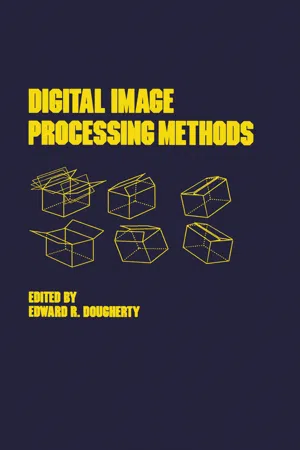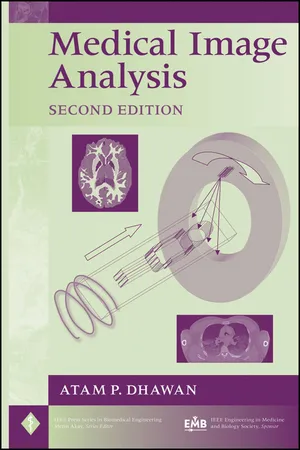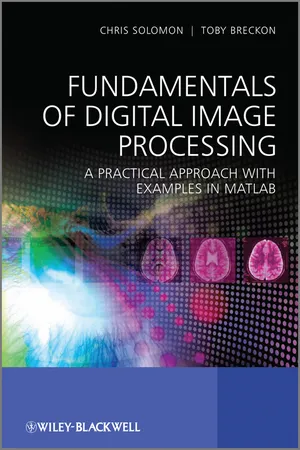Computer Science
Image Representation
Image representation refers to the methods used to store and manipulate visual data in a digital format. It involves converting images into a form that can be processed by computers, often using pixels to represent color and intensity. Common image representations include bitmap, vector, and digital signal processing techniques.
Written by Perlego with AI-assistance
Related key terms
Related key terms
1 of 4
Related key terms
1 of 3
3 Key excerpts on "Image Representation"
- eBook - ePub
- Edward R. Dougherty(Author)
- 2020(Publication Date)
- CRC Press(Publisher)
8Digital Image Compression
Paul W. Jones Majid Rabbani Eastman Kodak CompanyRochester, New YorkI. Introduction
The use of digital images has increased at a rapid pace over the past decade. Photographs, printed text, and other hard-copy media are now routinely converted into digital form, and the direct acquisition of digital images is becoming more common as sensors and associated electronics improve. Many recent imaging modalities in medicine, such as magnetic resonance imaging (MRI) and computed tomography (CT), also generate images directly in digital form. Computer-generated (synthetic) images are becoming an additional source of digital data, particularly for special effects in advertising and entertainment. The reason for this interest in digital images is clear: representing images in digital form allows visual information to be easily manipulated in useful and novel ways.The downside to representing images in digital form is that a large number of bits is required to represent even a single digital image, and with the rapid advances in sensor technology and digital electronics, this number grows larger with each new generation of products. Furthermore, the total volume of digital images produced each day increases as more applications are found. As a result, it becomes necessary to find efficient representations for digital images in order to (1) reduce the memory required for storage, (2 ) improve the data access rate from storage devices, and (3) reduce the bandwidth and/or the time required for transfer across communication channels. The branch of digital image processing that deals with this problem is called image compression (or sometimes, picture coding ). A few books are devoted entirely to the subject of image compression [1 -7 ], and numerous textbooks on image processing also contain detailed coverage [8 -12 ]. Several excellent review articles on image compression have been published in the literature [13 -18 ], and there have also been several special journal issues dedicated to image coding and visual communications [19 -27 - eBook - ePub
- Atam P. Dhawan(Author)
- 2011(Publication Date)
- Wiley-IEEE Press(Publisher)
CHAPTER 11 Image Representation, ANALYSIS, AND CLASSIFICATION An image is considered a representation of objects with specific properties that are utilized in the imaging process. The characterization (or appearance) of objects in the image depends on their specific properties and interaction with the imaging process. For example, an image of an outdoor scene captured by a photographic camera provides a characterization of objects using the reflected light from their surfaces. Thus, the appearance of objects in the image will depend on the reflective properties of surfaces, illumination, viewing angle, and the optics of the photographic camera. As described in Chapters 4–7, different medical imaging modalities provide different characterizations of the physiological objects based on their properties and the type and parameters of the imaging modality. For example, a T 1 -weighted magnetic resonance (MR) image of the brain would show a different contrast of soft tissue, ventricles, and cerebrospinal fluid than its T 2 -weighted MR image. In order to perform a computerized analysis of an image, it is important to establish a hierarchical framework of processing steps representing the image (data) and knowledge (model) domains. The hierarchical Image Representation with bottom-up and top-down analysis approaches is schematically presented in Figure 11.1. A scenario consists of a multiple image data set involving multidimensional, multimodality, or multisubject images and can be represented as a set of scenes consisting of specific objects in the corresponding images - eBook - ePub
Fundamentals of Digital Image Processing
A Practical Approach with Examples in Matlab
- Chris Solomon, Toby Breckon(Authors)
- 2011(Publication Date)
- Wiley(Publisher)
1RepresentationIn this chapter we discuss the representation of images, covering basic notation and information about images together with a discussion of standard image types and image formats. We end with a practical section, introducing Matlab’s facilities for reading, writing, querying, converting and displaying images of different image types and formats.1.1 What is an image?A digital image can be considered as a discrete representation of data possessing both spatial (layout) and intensity (colour) information. As we shall see in Chapter 5, we can also consider treating an image as a multidimensional signal.1.1.1 Image layoutThe two-dimensional (2-D) discrete, digital image I (m, n ) represents the response of some sensor (or simply a value of some interest) at a series of fixed positions (m = 1,2,. .., M ; n = 1,2,. .., N ) in 2-D Cartesian coordinates and is derived from the 2-D continuous spatial signal I (x , y ) through a sampling process frequently referred to as discretization. Discretization occurs naturally with certain types of imaging sensor (such as CCD cameras) and basically effects a local averaging of the continuous signal over some small (typically square) region in the receiving domain.The indices m and n respectively designate the rows and columns of the image. The individual picture elements or pixels of the image are thus referred to by their 2-D (m , n ) index. Following the Matlab® convention, I (m , n ) denotes the response of the pixel located at the mth row and nth column starting from a top-left image origin (see Figure 1.1 ). In other imaging systems, a column-row convention may be used and the image origin in use may also vary.Although the images we consider in this book will be discrete, it is often theoretically convenient to treat an image as a continuous spatial signal: I (x , y
Index pages curate the most relevant extracts from our library of academic textbooks. They’ve been created using an in-house natural language model (NLM), each adding context and meaning to key research topics.
Explore more topic indexes
Explore more topic indexes
1 of 6
Explore more topic indexes
1 of 4


